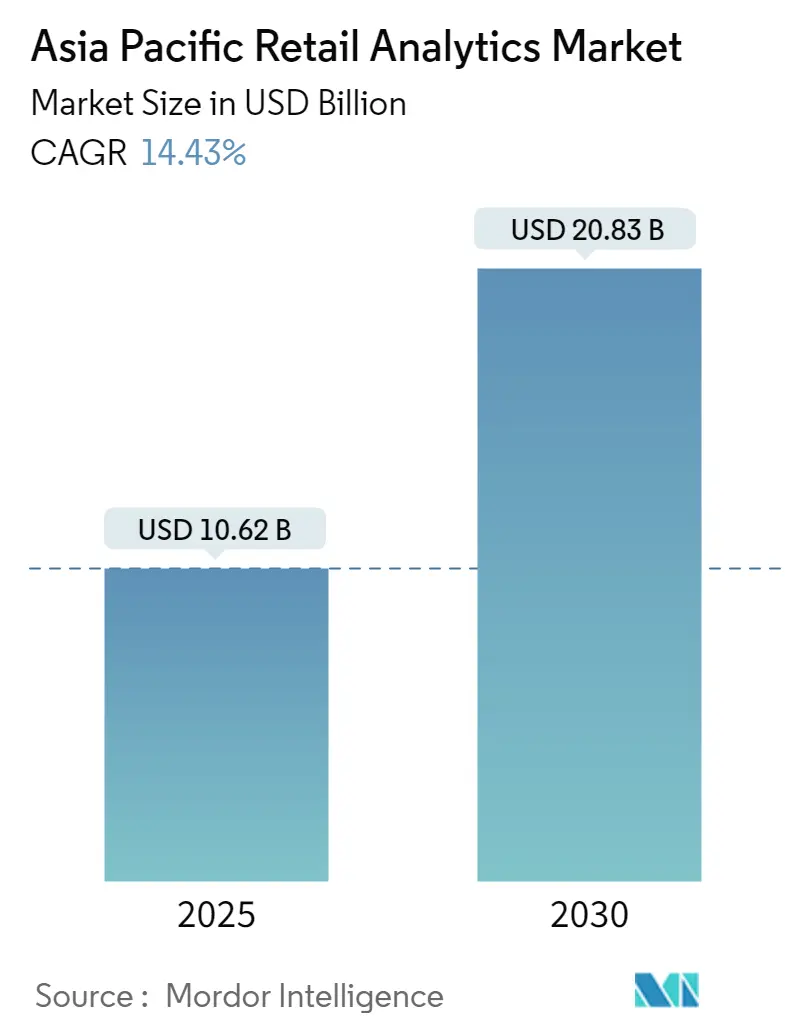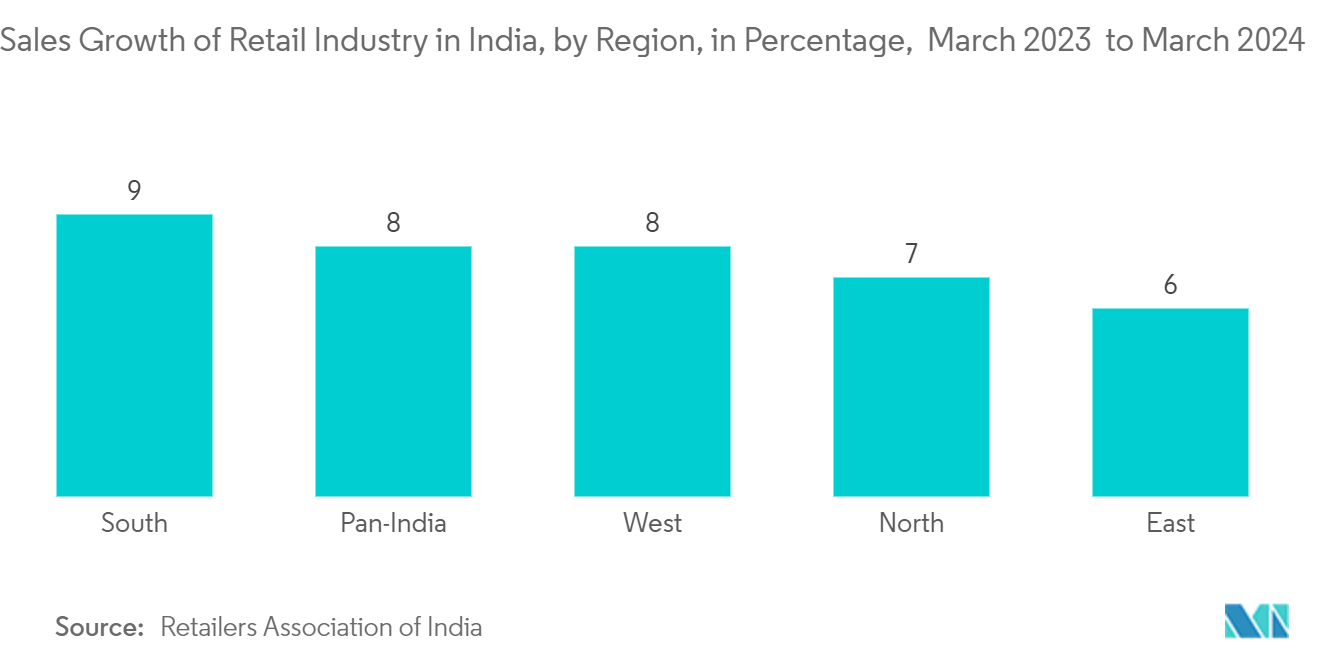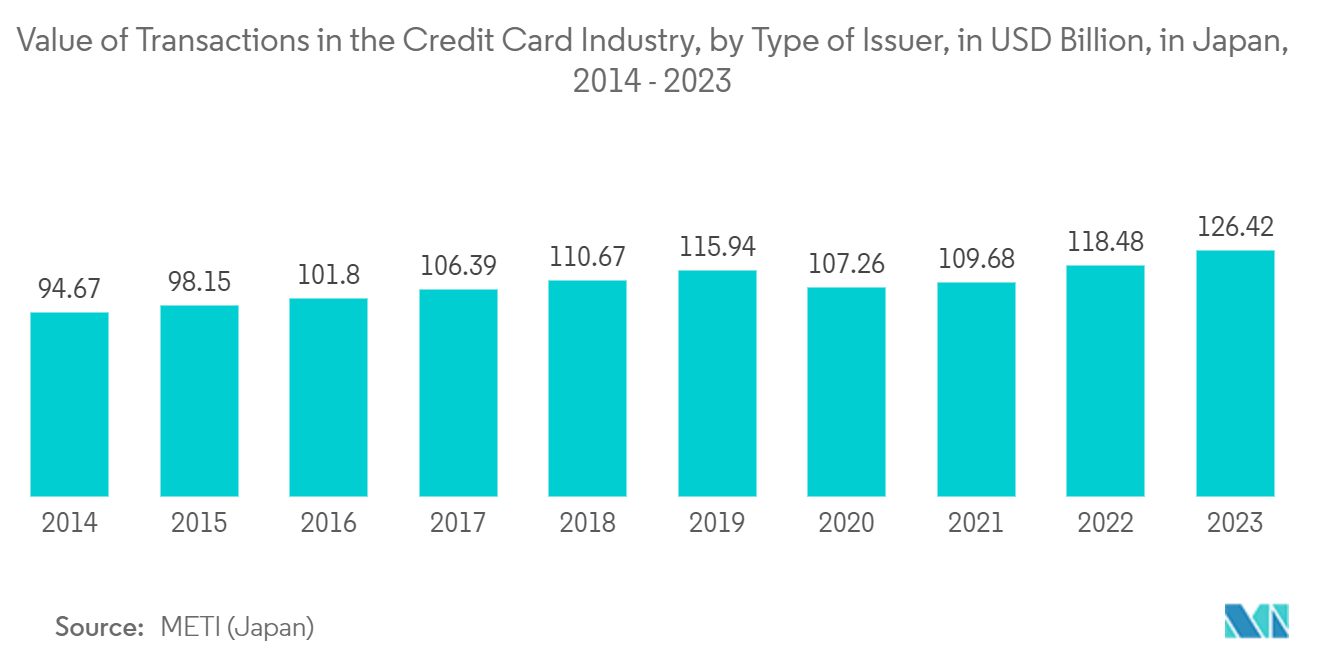
Asia Pacific Retail Analytics Market Analysis by Mordor Intelligence
The Asia Pacific Retail Analytics Market size is estimated at USD 10.62 billion in 2025, and is expected to reach USD 20.83 billion by 2030, at a CAGR of 14.43% during the forecast period (2025-2030).
- The market is expanding quickly due to retailers using the Internet of Things more frequently and adopting analytics tools faster.
- Retail analytics provides analytical data on inventory levels, supply chain movement, consumer demand, sales, etc., essential for marketing and procurement decisions. Retail analytics is the analysis of data generated by retail operations to make business decisions that drive profitability. Data analytics on supply and demand can be applied to maintain procurement levels and make marketing decisions.
- This includes offering insights to comprehend and improve the retail business's operational procedures, sales trends, consumer behavior, and overall performance. Because of consumers' high standards for retail today, companies must satisfy these growing demands with tailored omnichannel offers, practical procedures, and prompt adjustments to emerging trends. All of these activities require retail analytics. The market is expected to expand as more retail establishments open in countries such as China, Japan, India, and other developing nations.
- For instance, Reliance Retail announced in February 2023 that it planned to open multiple Gap stores next year with an eye toward the country's mid-premium apparel market. Reliance Retail acquired the rights to sell American casual wear brand Gap in India last year. The retailer plans to open 50 new locations overall in the upcoming year. The opening of such stores will increase demand for retail analytical solutions.
- Analytics can help retailers make better marketing decisions, improve business processes, and provide better overall customer experiences by identifying areas for improvement and optimization. The demand for analytical solutions in the sector is anticipated to increase with the rapid expansion of the retail industry across all countries. For instance, retail sales in Japan rose by 6.6% YoY in February 2023, exceeding market expectations of 5.8% and accelerating from a revised 5% growth in January. Retail trade increased for the 12th month, running the fastest since May 2021.
- Additionally, the retail sector's growing adoption of Industry 4.0 has significantly aided the market's expansion. The market for retail analytics is expanding due to the rising popularity of smartphones and e-commerce. During the forecast period, it is also anticipated that increasing income levels, government spending on big data and analytics, and demand for automated retail-based services will stimulate the regional retail analytics market.
- Retail analytics market growth is significantly constrained by the high capital expenditures required for installation, maintenance, testing, licensing, and other technical labor costs associated with retail analytics tools. Another factor impacting the market is the unorganized retail sectors' limited access to technology and tight budgets.
Asia Pacific Retail Analytics Market Trends and Insights
Solutions Segment is Anticipated to Hold Major Market Share
- The retail industry is becoming more competitive, so optimizing business processes and satisfying customer expectations is crucial. Every step includes the implementation of data analytical solutions. Customer heat mapping can also be used to optimize offers and product placement. Additionally, the retail industry's growing use of cloud services will soon open up opportunities in the Asia Pacific retail analytics market.
- Moreover, data management solutions are anticipated to dominate the region's retail analytic sector. One of the ways data is used in retail most frequently is for personalized marketing. If retailers focused more on the management side of data, their efforts could be significantly improved. For instance, adding data from third-party sources to their first-party information can help them target customers more precisely.
- Furthermore, the importance of data management solutions has grown within the retail and e-commerce sectors. Businesses can use data to enhance operations and provide better customer service as a result of the development of technology and the abundance of information now at their disposal. Better data management increases visibility across retail processes by compiling and structuring otherwise enormous, unmanageable data sets.
- One of the factors propelling the Asia-Pacific retail analytic industry is data analytical solutions. Data analytics has emerged as a game-changing technology in the retail sector that gives retailers strong tools to streamline their processes, enhance customer experiences, and boost sales. Retailers can use data analytics to create individualized recommendations, offers, and promotions by analyzing customer data such as purchase history, browsing behavior, and social media interactions.
- The retail sector in Asia-Pacific is constantly changing, and data analytics significantly impacts how retail will develop in the future. Moreover, the growth in retail sales coupled with increasing digitization in the retail sector is driving the adoption of retail analytics solutions among retail businesses in the emerging countries in Asia Pacific. For instance, according to the data from the Retailers Association of India (RAI), Pan India sales growth in the retail industry from February 2021 to February 2022 was 10%. Similarly, the sales growth in North India and Western India was 17% and 16% from February 2021 to February 2022.

Japan is Expected to Witness Significant Traction in APAC Retail Analytics Market
- The retail analytics market in Japan is analyzed to witness substantial growth in the coming years owing to the growth in retail sales and technological advancements in the retail sector coupled with the growing demand for data analytics in retail businesses. Moreover, the growing digital transformation in the country's retail sector is further offering substantial growth opportunities for the adoption of retail analytics solutions in the coming years.
- Additionally, retail analytics can significantly enhance marketing strategies. It can assist in customer targeting by identifying the ideal customer using information gathered on the location, age, preferences, buying patterns, and other significant factors of current and previous customers. Better data management will unlock data's full potential, improving retail operations on many fronts and enhancing the functionality of retailers' e-commerce sites. Thus propelling the demand for retail analytics solutions in Japan over the forecast period.
- Furthermore, it is anticipated that in the future, solutions like real-time analytics, artificial intelligence, and machine learning will become even more significant. These can aid retailers in increasing sales, streamlining their marketing plans, and giving customers a seamless experience. These solutions are anticipated to be used more frequently in retail businesses as part of data analytics solutions.
- Moreover, the demand is expected to grow at a rapid pace as more retail businesses and organizations, such as convenience stores, supermarkets, etc., adopt retail analytics solutions owing to growth in retail sales in the Japanese retail industry. For instance, according to the data from METI (Japan), the sales value of the retail industry in Japan exceeded JPY 150 trillion (USD 103.5 Trillion), out of which supermarkets accounted for the largest share of JPY 15.15 trillion (USD 10.45 trillion) as a standalone store type. Convenience stores followed as the second strongest retail type, with the sales of goods and services generating JPY 12.2 trillion (USD 8.41 trillion).

Competitive Landscape
The Asia Pacific Retail Automation Market exhibits semiconsolidated, with several major players dominating the industry. Key participants in this market include Oracle, IBM, SAP SE, Zoho, and Adobe Systems Incorporated, among others. These companies are continuously fortifying their market presence through various strategic initiatives, including acquisitions, product launches, and partnerships, which significantly contribute to the market's growth. Here are some recent developments within this sector:
In November 2022, Qlik introduced a transformative product known as "Qlik Cloud Data Integration." This Enterprise Integration Platform as a Service (eiPaaS) offering is designed to empower enterprise data strategies. It achieves this by creating a real-time data integration fabric connecting all enterprise applications and data sources to the cloud. By harnessing the capabilities of the cloud and establishing real-time data connections between diverse data sources, targets, and destinations, Qlik Cloud Data Integration enables all members of the enterprise to make data-driven decisions with confidence.
In March 2022, Informatica, a renowned enterprise data management vendor, unveiled the first retail-specific version of its "Intelligent Data Management Cloud" (IDMC). This specialized platform, known as "Intelligent Data Management Cloud for Retail," leverages Informatica's suite of machine learning-powered tools to assist retailers in cataloging, ingesting, integrating, and preparing data for use in analytical and AI applications. This tailored solution caters to the unique data management needs of the retail sector, further enhancing its capabilities.
Asia Pacific Retail Analytics Industry Leaders
Oracle Corporation
IBM Corporation
SAP SE
Retail Next, Inc.
Qlik Technologies, Inc.
- *Disclaimer: Major Players sorted in no particular order
.webp)
Recent Industry Developments
- May 2024 - Nagarro, a prominent global digital engineering firm, has forged a strategic alliance with MoEngage, a top-tier Customer Engagement Platform driven by insights. This partnership aims to empower clients in their digital marketing transformations, emphasizing the creation of a cohesive marketing ecosystem through the strategic use of customer data intelligence. Through this collaboration, Nagarro joins MoEngage's esteemed Catalyst Partner program, designed to accelerate brand growth.
- October 2023 - Criteo, the commerce media company, and GroupM, WPP’s media investment group, announced the first Asia Pacific (APAC) partnership to Unify product sales data with proximity-based insights, enable omnichannel commerce through in-store and retail media integration, and strengthen omnichannel commerce media capabilities for GroupM clients in the region. The partnership combines product sales data and GroupM's proprietary media solutions with privacy-safe commerce audiences and proximity-based insights provided by Criteo.
Asia Pacific Retail Analytics Market Report Scope
Retail analytics provides analytics tools in the retail industry on business trends, patterns, and performance. Retail business analytics enable retailers to leverage data-driven insights from their businesses and customers to improve the consumer experience, increase sales, and optimize business operations.
The Asia Pacific retail analytics market is segmented by mode of deployment (on-premise and on-demand), by type (solutions and services), by module type (strategy and planning, marketing, financial management, store operations, merchandising, supply chain management), by business type (small & medium enterprises, large-scale organizations, and other module types), and geography (China, Japan, India, South Korea, and the Rest of Asia Pacific).
The market sizes and forecasts are provided in terms of value (USD) for all the above segments.
| On-Premise |
| On-Demand |
| Solutions (Analytics, Visualization Tools, Data Management, etc.) |
| Services (Integration, Support & Consulting) |
| Strategy & Planning (Macro Trends, KPI, Value Analysis) |
| Marketing (Pricing, Loyalty and Segment Analysis) |
| Financial Management (Accounts Management) |
| Store Operations (Fraud Detection, Workforce Analytics) |
| Merchandising (Assortment Optimization, Shopper Path Analytics) |
| Supply Chain Management (Inventory, Vendor and Supply-Demand Modelling) |
| Other Module Types |
| Small and Medium Enterprises |
| Large-scale Organizations |
| China |
| India |
| Japan |
| South Korea |
| By Mode of Deployment | On-Premise |
| On-Demand | |
| By Type | Solutions (Analytics, Visualization Tools, Data Management, etc.) |
| Services (Integration, Support & Consulting) | |
| By Module Type | Strategy & Planning (Macro Trends, KPI, Value Analysis) |
| Marketing (Pricing, Loyalty and Segment Analysis) | |
| Financial Management (Accounts Management) | |
| Store Operations (Fraud Detection, Workforce Analytics) | |
| Merchandising (Assortment Optimization, Shopper Path Analytics) | |
| Supply Chain Management (Inventory, Vendor and Supply-Demand Modelling) | |
| Other Module Types | |
| By Business Type | Small and Medium Enterprises |
| Large-scale Organizations | |
| Geography | China |
| India | |
| Japan | |
| South Korea |
Key Questions Answered in the Report
How big is the Asia Pacific Retail Analytics Market?
The Asia Pacific Retail Analytics Market size is expected to reach USD 10.62 billion in 2025 and grow at a CAGR of 14.43% to reach USD 20.83 billion by 2030.
What is the current Asia Pacific Retail Analytics Market size?
In 2025, the Asia Pacific Retail Analytics Market size is expected to reach USD 10.62 billion.
Who are the key players in Asia Pacific Retail Analytics Market?
Oracle Corporation, IBM Corporation, SAP SE, Retail Next, Inc. and Qlik Technologies, Inc. are the major companies operating in the Asia Pacific Retail Analytics Market.
What years does this Asia Pacific Retail Analytics Market cover, and what was the market size in 2024?
In 2024, the Asia Pacific Retail Analytics Market size was estimated at USD 9.09 billion. The report covers the Asia Pacific Retail Analytics Market historical market size for years: 2019, 2020, 2021, 2022, 2023 and 2024. The report also forecasts the Asia Pacific Retail Analytics Market size for years: 2025, 2026, 2027, 2028, 2029 and 2030.
Page last updated on:
Asia Pacific Retail Analytics Market Report
Statistics for the 2025 Asia Pacific Retail Analytics market share, size and revenue growth rate, created by Mordor Intelligence™ Industry Reports. Asia Pacific Retail Analytics analysis includes a market forecast outlook for 2025 to 2030 and historical overview. Get a sample of this industry analysis as a free report PDF download.
.webp)


